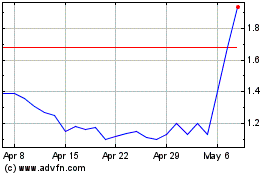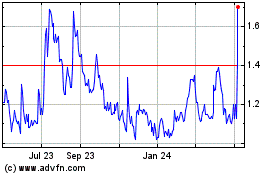NanoViricides, Inc. (NYSE MKT:NNVC) (the “Company”) reports that
its President, Dr. Anil Diwan, was invited to present the FluCide™
data at the 3rd Annual Influenza Research and Development
Conference on Friday, July 11, at 0850 am. The Conference ran from
July 9-11 at the Hyatt Regency in Boston, MA, and was held by GTC
Bio
(https://www.gtcbio.com/conferences/influenza-research-and-development-agenda).
Dr. Diwan discussed the nanoviricides® technology platform, and
presented the pre-clinical data on the Company’s first drug
candidate, NV-INF-1, Injectable FluCide™, to treat all influenza
infections in hospitalized patients. Influenza A H1N1 infected
animals treated with FluCide survived the full 21-day observation
period, whereas animals treated with 40mg/kg/d oseltamivir
phosphate (Tamiflu®) survived only 8 days in this highly lethal
study. Influenza A/WS/33/ (H1N1) virus was used in this study. The
highly lethal infectious dose of 1M viral particles at time 0 h
followed by another 1M virus particles at 23h that was employed
caused uniform lethality in 5 days in untreated mice. Body weight
began to decline in the infected, untreated mice, by days 2-3 days
and continued to decline until death. The Oseltamivir-treated mice
maintained body weight only through day 5, which declined
thereafter until death. Similar to the survival results, the mice
treated with NV-INF-1 maintained their body weight substantially
longer, through day 14. NV-INF-1 demonstrated an unparalleled
1,000-fold reduction in lung viral load compared to untreated
animals on day 4 in this lethal animal model study. Moreover, the
lung viral load was suppressed to this baseline level through 13
days or longer, with a slight increase on day 19. In contrast, the
current standard of care, oseltamivir, (Tamiflu®, Roche) exhibited
only a 2-fold reduction in lung viral load at day 4, that rapidly
rose by approximately 2X on day 7. Similar to the reduced virus
titers, on day 4 the lungs from mice that were treated with
NV-INF-1 showed a substantially lower lung weight (healthy) and
displayed a markedly reduced presence of virus-induced lesions as
compared to the untreated control and oseltamivir. Also similar to
lung virus titers, the reductions in lung lesions in animals
treated with NV-INF-1 were maintained at least through 13 days.
Dr. Diwan also discussed the extremely high safety of NV-INF-1
observed in preliminary safety/toxicology studies. He noted that no
significant changes in all observed parameters were found even at
the maximum feasible dose of approximately 2,700 mg/kg/d repeatedly
given for five consecutive days.
He also presented the data on NV-INF-2, the Company’s current
oral anti-influenza drug candidate. NV-INF-2 has the same antiviral
ligand as NV-INF-1, but a different polymeric backbone that has
enabled significant oral effectiveness. NV-INF-2 has been evaluated
in a mouse model of influenza virus infection using two different
influenza virus a strains, A/WS/33/ (H1N1) and A/W/67 (H3N2v).
NV-INF-2 treated mice survived as long as 14.5 days in an H1N1
lethal infection study, and for 15.6 days in an H3N2 lethal
infection study. Oseltamivir treated animals died in only 7.6 days
in H1N1 infection study, and in 9.6 days in the H3N2 study. The
lethal infection viral dose and protocol was chosen such that the
untreated animals died in 5 days in both H1N1 and H3N2 studies.
Similar to substantially increased survival, NV-INF-2 also
exhibited substantially superior reduction in lung viral titer and
protection of lungs from lesions.
The data indicate that both NV-INF-1 and NV-INF-2 are highly
effective, broad-spectrum, anti-influenza drugs. The Company has
shown that they are effective against both group I and group II
influenza A viruses.
Dr. Diwan also reported that the Company is successfully scaling
up production of NV-INF-1 for the GLP Safety/Toxicology study at
its current facilities. In addition, he reported that construction
of the Company’s new facility capable of cGMP production of all of
the Company’s nanoviricides drug candidates for human clinical
batches is now complete. Facility testing and validation are in
progress.
The market size for an effective influenza drug for treating
severely ill hospitalized patients has been estimated in the
billions of dollars, worldwide, depending upon the therapeutic
value and cost savings. Currently, there is no effective
therapeutic available for this indication. The Company believes
that it could supply a substantial portion of the demand for this
drug from its new small scale cGMP clinical drug facility. This
drug is currently in IND-enabling studies.
This broad-spectrum FluCide drug is expected to work against
most, if not all, forms of influenza virus, including epidemic,
pandemic (e.g. H1N1/2009), high path influenzas such as H3N2, H7N9,
and “bird flu” such as H5N1.
The total market size addressed by the Company’s current drug
programs is estimated at about $50 billion. In addition to
Injectable FluCide, the Company is working on five more
commercially important drug candidates, namely: DengueCide™,
HerpeCide™, HIVCide™, Oral FluCide™ for out-patients, and a
broad-spectrum antiviral drug for viral diseases of the external
eye. All of our programs are for therapeutics to treat viral
infections. Our drugs are expected to be useful as prophylactics as
well. DengueCide has recently received orphan drug designation by
the US FDA as well as the European EMA.
NanoViricides recently received an important international
award, the “IAIR Award 2014 for Leadership in Nanomedicines in the
North American Sector”.
The Company currently has approximately $41 million cash-in-hand
and cash-like-instruments. These funds are estimated to be
sufficient for taking at least one of our drug candidates through
initial human clinical trials, and possibly take another drug
candidate into human clinical trials.
About GTCBio:
GTCbio is a leading information center that provides quality
forums, which facilitate the exchange of biopharmaceutical and
biomedical intelligence between industry leaders, academic and
government organizations, and the financial community. Our
conferences cover a variety of topics, such as stem cell
therapeutics, infectious diseases, biotech partnering,
pharmaceutical litigation, government regulation, bio-based
chemicals and many more. Founded in 2002, GTCbio stimulates
scientific discussions, offers key business insights, and promotes
partnering and deal-making in the ever-changing biotech and
pharmaceutical world.
About NanoViricides:
NanoViricides, Inc. (www.nanoviricides.com) is a development
stage company that is creating special purpose nanomaterials for
viral therapy. The Company's novel nanoviricide® class of drug
candidates are designed to specifically attack enveloped virus
particles and to dismantle them. The Company is developing drugs
against a number of viral diseases including H1N1 swine flu, H5N1
bird flu, seasonal Influenza, HIV, oral and genital Herpes, viral
diseases of the eye including EKC and herpes keratitis, Hepatitis
C, Rabies, Dengue fever, and Ebola virus, among others.
This press release contains forward-looking statements that
reflect the Company's current expectation regarding future events.
Actual events could differ materially and substantially from those
projected herein and depend on a number of factors. Certain
statements in this release, and other written or oral statements
made by NanoViricides, Inc. are “forward-looking statements” within
the meaning of Section 27A of the Securities Act of 1933 and
Section 21E of the Securities Exchange Act of 1934. You should not
place undue reliance on forward-looking statements since they
involve known and unknown risks, uncertainties and other factors
which are, in some cases, beyond the Company's control and which
could, and likely will, materially affect actual results, levels of
activity, performance or achievements. The Company assumes no
obligation to publicly update or revise these forward-looking
statements for any reason, or to update the reasons actual results
could differ materially from those anticipated in these
forward-looking statements, even if new information becomes
available in the future. Important factors that could cause actual
results to differ materially from the company's expectations
include, but are not limited to, those factors that are disclosed
under the heading "Risk Factors" and elsewhere in documents filed
by the company from time to time with the United States Securities
and Exchange Commission and other regulatory authorities. Although
it is not possible to predict or identify all such factors, they
may include the following: demonstration and proof of principle in
pre-clinical trials that a nanoviricide is safe and effective;
successful development of our product candidates; our ability to
seek and obtain regulatory approvals, including with respect to the
indications we are seeking; the successful commercialization of our
product candidates; and market acceptance of our products.
NanoViricides, Inc.Amanda Schuon, 310-550-7200info@nanoviricides.com
NanoViricides (AMEX:NNVC)
Historical Stock Chart
From Mar 2024 to Apr 2024

NanoViricides (AMEX:NNVC)
Historical Stock Chart
From Apr 2023 to Apr 2024
